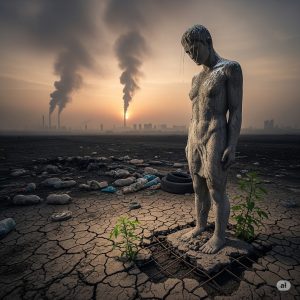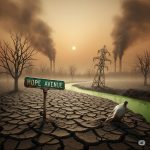
In the year 2000, the Nobel Prize-winning atmospheric chemist Paul Crutzen announced at an international scientific meeting that planet Earth had entered a new geological epoch, the epoch he dubbed the “Anthropocene” which means the “age of humanity.”[1]
To better understand this new epoch, we find ourselves in today, we’ll consider four questions.
Question #1: What is the Anthropocene?
The theologian Norman Wirzba describes the arrival of Anthropocene as the moment “(some) humans became the dominant force in planetary history, responsible for the widespread alteration of the world’s land, ocean, atmospheric, and life systems.”[2]
Question #2: How did we arrive at the Anthropocene?
Paul Crutzen, the scientist who dubbed this epoch the Anthropocene in 2000 argued that this epoch started in 1784 with the invention of the steam engine by James Watt.[3] And this isn’t a bad date, given that steam engines burn fossil fuel (initially coal, eventually oil and gas), the very thing that has led to the heating up of our planet. Others reach further back, for example, to 1610 when imperial expansion and transoceanic movement started, causing unprecedented relocation of plant and animal life around the globe. So, maybe 1784. Or maybe 1610. But it has been latent since humans appeared on Earth.
Question #3: Is it good, bad, or neutral that we are now living in the age of humanity?
There are two basic views on the arrival of the Anthropocene, we’ll call them the optimists and the pessimists.
The Optimists: Some embrace the rise of the Anthropocene as an opportunity to creating a techno-utopian society. Consider the signatories of An Ecomodernist Manifesto, published in 2015, for example. The signers argue that “knowledge and technology, combined with wisdom, might allow for a good, or even great, Anthropocene.”[4]
The Pessimists: But not all think that the Anthropocene is a good thing, partly because it has given us paradoxical results: increased wealth, leisure, and human freedom (at least in the West) coupled with the degradation of the Earth and the life systems on which all creatures depend.[5]
Question #4: What does faithfulness to Christ look like considering this cultural moment? (i.e., because we now live in the Anthropocene)?
What might call the central problem of the Anthropocene the “problem of agency.”
How can we deal with, and even respond to the problem of agency? The answer, in a word: limits. In three words: creaturely entangled limits.
Preview: given our new geological epoch, and its problems, we have four options (as Norman Wirzba puts it in his book This Sacred life are: fix, adapt, leave, or die.[6]
 [1] Norman Wirzba, This Sacred Life (Cambridge University Press, 2021), 3.
[1] Norman Wirzba, This Sacred Life (Cambridge University Press, 2021), 3.
[2] Ibid., xiv.
[3] Wirzba, This Sacred Life, 9. This paragraph summarizes Wirzba’s discussion of the dating the Anthropocene.
[4] Quoted in Wirzba, This Sacred Life, 4; see the manifesto at www.ecomodernism.org/.
[5] Wirzba, This Sacred Life, 4–5.
[6] Wirzba, This Sacred Life, 42.




